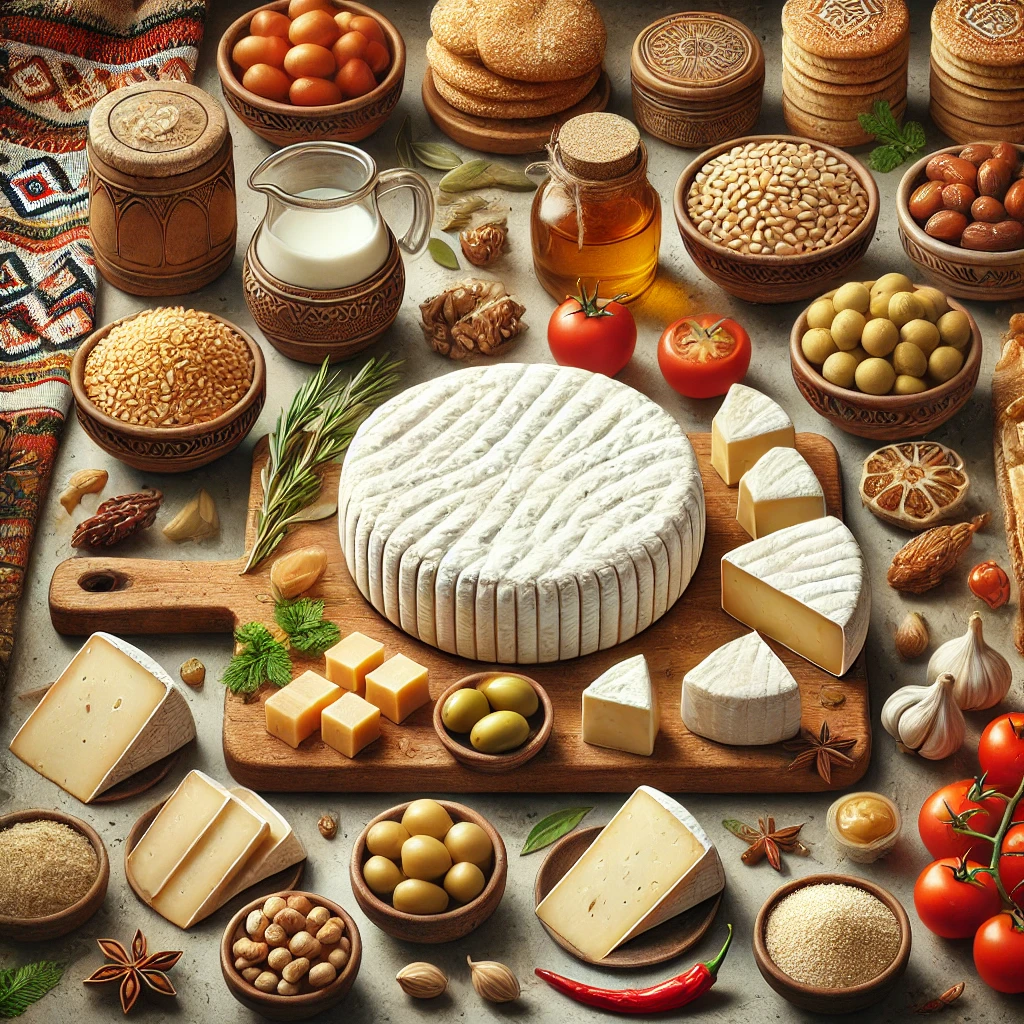Algeria’s culinary heritage is rich, diverse, and deeply tied to its landscapes and communities. While the country is widely known for couscous, tagines, and flatbreads, its traditional cheeses remain largely undiscovered outside North Africa. One such hidden gem is Tafoughalt cheese, a rare and authentic dairy product originating from eastern Algeria.
Tafoughalt cheese is a traditional, handmade cheese produced in rural and mountainous areas, especially among Berber communities. Valued for its simplicity, nourishment, and cultural meaning, Tafoughalt cheese reflects centuries of pastoral life, where food was crafted to sustain families rather than impress markets.
Geographic Origins and Cultural Background
Tafoughalt cheese takes its name from Tafoughalt, a mountainous region near the Algerian–Moroccan border. This area is known for its rugged terrain, seasonal grazing, and strong Berber identity. Cheese-making here developed out of necessity, using fresh milk from locally raised animals and simple techniques adapted to a warm, dry climate.
In these communities, cheese is not a commercial product but a household staple, often made by women using knowledge passed down orally through generations. Tafoughalt cheese plays a role in daily meals, hospitality traditions, and seasonal food preservation.
Historical Roots of Tafoughalt Cheese
Cheese-making in North Africa predates colonial influence. Long before European techniques arrived, Berber pastoralists were already processing milk into curds, butter, and fresh cheeses to extend shelf life.
Tafoughalt cheese emerged from this tradition as a fresh or lightly dried cheese, designed for immediate consumption or short-term storage. Unlike aged European cheeses, it does not rely on long maturation but on freshness, cleanliness, and balance.
Milk Source and Ingredients
Tafoughalt cheese is traditionally made from goat’s milk or sheep’s milk, though cow’s milk may be used depending on availability.
Core Ingredients
-
Fresh raw milk
-
Natural acidity (soured milk or whey)
-
Salt (optional and minimal)
No artificial cultures or additives are used, keeping the cheese natural and close to its pastoral origins.
Traditional Production Method
The production of Tafoughalt cheese is simple yet precise, relying on experience rather than written recipes.
Traditional Steps
-
Fresh milk is gently warmed
-
Natural curdling occurs through acidity
-
Curds are separated from whey
-
Curds are lightly pressed or shaped by hand
-
Cheese may be briefly dried or salted
The cheese is usually consumed fresh, though some families lightly dry it to extend usability.
Texture and Appearance
Tafoughalt cheese has a rustic, handmade character.
| Feature | Description |
|---|---|
| Texture | Soft to semi-firm |
| Moisture | Medium |
| Color | White to pale cream |
| Shape | Irregular, hand-formed |
Its appearance reflects traditional craftsmanship rather than uniformity.
Taste Profile of Tafoughalt Cheese
The flavor of Tafoughalt cheese is clean, mild, and gently tangy.
Flavor Characteristics
-
Fresh dairy notes
-
Light acidity
-
Mild saltiness (if salted)
-
Earthy undertones from animal diet
The taste is subtle, making it well-suited to simple meals and regional dishes.
Variations of Tafoughalt Cheese
There is no single standardized version of Tafoughalt cheese. Variations depend on household practices.
Fresh Tafoughalt
-
Soft and moist
-
Consumed within days
-
Mild flavor
Lightly Dried Tafoughalt
-
Firmer texture
-
Slightly stronger taste
-
Improved shelf life
Herb-Influenced Versions
-
Occasionally mixed with local herbs
-
Adds gentle aromatic notes
These variations highlight local creativity rather than formal classification.
Traditional Culinary Uses
Tafoughalt cheese is a functional food, integrated into daily cooking.
Common Traditional Uses
-
Served with flatbread
-
Paired with olives and olive oil
-
Crumbled into couscous
-
Eaten with dates or honey
Its simplicity allows it to complement both savory and sweet foods.
Modern and Contemporary Uses
As interest in indigenous foods grows, Tafoughalt cheese is gaining attention from chefs and food historians.
Modern Applications
-
Farm-to-table menus
-
Cheese tastings focused on heritage foods
-
Vegetarian protein source
-
Fusion dishes blending North African and Mediterranean flavors
Despite this interest, Tafoughalt cheese remains mostly artisanal and local.
Best Food Pairings for Tafoughalt Cheese
Traditional Pairings
-
Semolina or barley bread
-
Olive oil
-
Dates and figs
Fresh Pairings
-
Cucumbers
-
Tomatoes
-
Fresh herbs
Sweet Pairings
-
Honey
-
Fruit preserves
These pairings enhance the cheese’s natural freshness.
Beverage Pairings
Tafoughalt cheese pairs best with light, traditional drinks.
Beverage Options
-
Mint tea
-
Herbal infusions
-
Buttermilk
-
Fresh water
These beverages complement its mild character.
Nutritional Value
Tafoughalt cheese offers essential nourishment.
Nutritional highlights include:
-
High-quality protein
-
Calcium and phosphorus
-
Natural fats
-
Minimal processing
Because it is traditionally made and lightly processed, it fits well into balanced diets.
Tafoughalt Cheese vs Other Algerian Cheeses
| Feature | Tafoughalt | Other Algerian Cheeses |
|---|---|---|
| Aging | Fresh or lightly dried | Sometimes aged |
| Flavor | Mild | Stronger |
| Use | Daily meals | Special dishes |
| Production | Household | Small-scale artisanal |
Tafoughalt stands out for its everyday practicality.
Buying and Storing Tafoughalt Cheese
Buying Tips
-
Purchase from trusted local producers
-
Look for fresh aroma and clean appearance
-
Avoid overly dry texture unless intentionally dried
Storage Tips
-
Refrigerate if available
-
Consume quickly
-
Keep in covered containers
Freshness is essential for quality and safety.
Cultural Importance Today
Tafoughalt cheese represents living heritage. In an era of industrial food, it preserves ancestral knowledge, local agriculture, and sustainable practices. For many Algerian families, it remains a symbol of home, land, and tradition.
As global interest in traditional foods increases, Tafoughalt cheese offers an authentic taste of Algeria’s rural identity.
Conclusion
Tafoughalt cheese from Algeria is a humble yet meaningful delicacy. Made with fresh milk, simple techniques, and deep cultural knowledge, it reflects the values of nourishment, simplicity, and community.
Whether enjoyed traditionally with bread and olive oil or rediscovered in modern cuisine, Tafoughalt cheese remains a powerful expression of Algeria’s culinary heritage. Exploring it is not just about flavor—it is about understanding the people, landscapes, and traditions that shaped it.
Frequently Asked Questions (FAQ)
What is Tafoughalt cheese made from?
It is traditionally made from goat’s or sheep’s milk, sometimes cow’s milk.
Is Tafoughalt cheese aged?
No, it is usually fresh or lightly dried.
How does Tafoughalt cheese taste?
It has a mild, fresh, slightly tangy flavor.
How is Tafoughalt cheese traditionally eaten?
It is eaten with bread, olive oil, couscous, dates, or honey.
Is Tafoughalt cheese widely available?
It is mostly produced locally and rarely exported, making it a rare regional delicacy.



